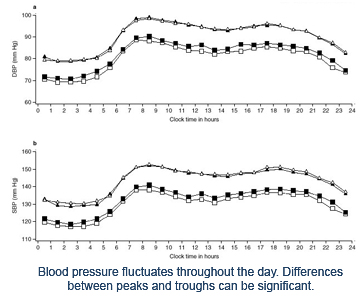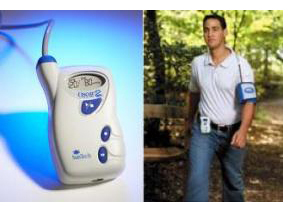Many people reading this article can readily quote a pair of figures they believe to represent their blood pressure. But what do these figures really mean? And, more importantly, can you justify potentially life-altering health decisions - often involving powerful medications – on these two numbers?
Think about it: treatment with blood pressure medication can last a lifetime and yet conventional blood pressure readings are only a snapshot of your condition at a certain moment in time. There are two serious problems with them:
Like the stock market, blood pressure rises and dips throughout the day. For many people it peaks around midday but for others it spikes early in the morning. The difference between the peaks and troughs can be significant yet many people and even some doctors routinely measure blood pressure at the same time each day.

Also like the stock market, blood pressure responds instantly to shocks and stresses, whether real or simply perceived. Blood pressure will react to both physical shocks such as illness or strong emotions as well as less-defined stresses such as worry over losing one’s job. Doctors used to dismiss the role stress plays in hypertension but we now know that chronic stress can have real physical consequences through its production of harmful stress hormones.
The flip side of this is that relaxation can bring about significant drops in blood pressure. Which would you prefer when taking your blood pressure: tension or relaxation? Choosing your time can make a world of difference.
To counter the many temporary factors affecting your blood pressure experts usually recommend taking readings at various times and in a relaxed state after a few minutes of rest. Yet how many people can recount instances in which they’ve rushed to a doctor’s appointment only to be whisked into a screening room where their blood pressure is immediately taken by a doctor or nurse? No wonder it’s high!
But for some people with “white-coat syndrome” a long stretch in the waiting room can be even worse. For these people the stress of seeing the doctor as well as the medical setting itself causes a higher than usual reading. In fact, some people can get themselves so worked up about their readings that they even experience the syndrome while taking their own blood pressure in a normally comfortable home setting.
Doctors once disputed its significance but white-coat syndrome is very real and can have serious consequences. How many people have been prescribed expensive, troublesome and even dangerous medications on account of the time of day or the temporary effects of stress?
Now let’s assume you’re getting your blood pressure readings at varying times of the day after a short rest as recommended. What else can mislead you?
2. Incorrect or inconsistent procedures/equipment
Taking blood pressure should be a standardized procedure in order to have any real meaning, yet in practice there are numerous variations. Even doctors and other medical professionals who should know better consistently make critical errors when taking blood pressure readings.
Simply the way you hold your arm, for example, can make a huge difference. Readings should be taken with the arm held at a right angle to the body with the elbow flexed and with the cuff at the same level as the heart. Readings taken with incorrect arm or cuff positions can be up to 10% higher than those taken correctly. In many cases ten percent can make the difference between an “all clear” and a prescription and yet a recent study found that 73% of health care workers used incorrect arm and/or cuff positions.
Then there’s the home blood pressure monitor. The development of inexpensive and easy to use digital monitors for the home is generally a great thing. It offers the ability to take blood pressure at any time of the day, under various conditions and in the comfort of one’s own home.
Of course, users of these devices need to be just as diligent of correct and consistent procedures but they face one other important question: just how accurate are these machines? Though we expect modern digital equipment to be highly reliable you may want to try this little experiment: take your blood pressure several times in succession with a brief rest after each reading. Make sure you follow the same procedure each time.
How consistent are the figures? You may be surprised, not to mention dismayed, with the findings, even from the best machines. Readings from public blood pressure machines in drug stores and pharmacies can be just as inconsistent, even though they are regularly checked and calibrated.
This is not to say that these machines are useless. They can be a good early indicator of blood pressure problems but you should always get your results confirmed by a medical expert before jumping to any conclusions. Professional equipment and correct procedures combined with medical expertise should give an accurate static blood pressure reading. But does this lead to an accurate diagnosis?
Don’t settle for a snapshot when you can have the movie
I’m talking about Ambulatory Blood Pressure Monitoring (ABPM). With ABPM, the subject wears sensors attached to a lightweight, digital device that can be nearly as small as an mp3 player. The device takes automatic blood pressure measurements at selected intervals throughout a 24 to 48 hour period. While conventional static readings are just a small picture of your condition, ABPM reveals a dynamic panorama of the up and down movements of your blood pressure around the clock.
 Previously
used mainly for research
purposes and in limited
hypertension applications such as suspected white-coat syndrome, ABPM
is
increasingly recognized as a highly accurate diagnostic tool for many
cases of
hypertension. Because ABPM reveals a much bigger picture of your blood
pressure
it is far more accurate than static readings. More importantly, it has
been
shown to correlate more closely with end-organ damage and other health
risks
resulting from high blood pressure.
Previously
used mainly for research
purposes and in limited
hypertension applications such as suspected white-coat syndrome, ABPM
is
increasingly recognized as a highly accurate diagnostic tool for many
cases of
hypertension. Because ABPM reveals a much bigger picture of your blood
pressure
it is far more accurate than static readings. More importantly, it has
been
shown to correlate more closely with end-organ damage and other health
risks
resulting from high blood pressure.
Of course the drugs used to treat hypertension carry their own risks, not to mention side effects. And they can easily develop into a lifelong liability. One unexpected benefit of ABPM is that, when used early enough, it may reveal ways in which lifestyle changes can be used to bring about reductions in blood pressure, thus avoiding medication. Blood pressure may be shown to rise, for example, at times of exposure to certain stresses. These stresses can then be identified and dealt with. ABPM may also reveal reactions to medications you may be taking, many of which can contribute to high blood pressure.
Ambulatory Blood Pressure Monitoring naturally costs more than a conventional blood pressure check but prices have come down and can run from as low as $100 (USD) to around $350. Insurers in the U.S. have often failed to cover it as they classified it “investigative” but as their position has begun to change ABPM is being used increasingly. Even when the cost is “out of pocket” it’s surely a wise investment that will repay itself many times over if it helps to avoid expensive drug treatment.
When you consider the far-reaching health implications of high blood pressure and its treatment, ABPM makes a lot of sense. I personally would hesitate to make a serious health decision relating to my blood pressure on the basis of anything less.
Click here to discover a genuinely effective way to lower blood pressure naturally.